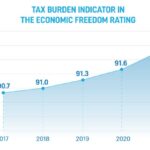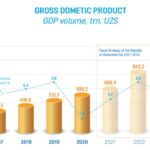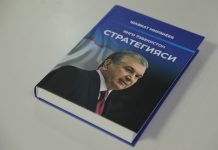Eldor Tulyakov,
Executive Director,
Development Strategy Center
Furkat Yunusov,
Head of Department,
Development Strategy Center
Four years ago, Uzbekistan launched reforms critical to the development of its economic sphere. Based on the Strategy of Actions, the document responsible for outlining the priorities for the country’s growth for the period of 2017-2021, as a metric we have arrived at initial finding, with several indicators demonstrating progress, most notably the areas of public administration, social and civic institutions, mass-media, economic advances, among others. The past four years have evidenced precise results and demonstrated more advanced methods to advance these priority areas.
Openness and transparency
Using the priorities established by the Strategy of Actions as a guidepost, relations between Uzbekistan, partner countries, and international financial institutions have improved considerably. Uzbekistan understands that to become an active participant in global economic processes; the Republic needs to keep the international community, including foreign investors, international rating agencies, and financial institutions, informed about its macroeconomic reforms, including the monetary and banking sector reforms. In this regard, the government, all ministries and departments, and the Central Bank have established a practice of regular and open publication of all statistical and analytical data on macroeconomic indicators, state budget execution, money supply, and the state of gold and foreign exchange reserves.
In particular, experts from the IMF conducted a study to assess budget transparency, the quality of public finance statistics, and the accuracy of public sector data. For the first time in Uzbekistan, starting from 2018, the “Budget for Citizens” is regularly published for citizens to view[1]. Now it is standard practice to publish all stages of the budget process through Social Media. Also, starting from 2018, statistics on the balance of payments and international investment position of Uzbekistan are posted on the Central Bank’s website in Uzbek, Russian and English, and in the IMF’s data distribution systems every quarter[2].
In 2019, Uzbekistan’s page was present on the leading statistical data platform of the IMF – International Financial Statistics[3].
In 2020, Uzbekistan ranked 44th globally and 1st in Central Asia with 63 points in the Open Data Inventory (ODIN). Uzbekistan has the most significant increase among Asian countries in the open data ranking, rising by 125 positions[4]. As a result, the international community’s attitude, international organizations, and financial institutions toward Uzbekistan have changed, with all entities recognizing the efficacy of the ongoing reforms.
International relations and cooperation
At the end of 2016, the country restored full-fledged relations with international financial institutions and the world community. As a result, the French Development Agency launched its first project in Uzbekistan[5]. Since 2016, 7 operations have been granted by AFD to the Government of Uzbekistan by financing projects in various sectors and public policy budgetary loans for a cumulative amount of commitments of more than € 630 million of sovereign loans. AFD plans to mobilize about one billion euros in the form of loans, technical assistance and grants to support the reform agenda of the Government of Uzbekistan by 2025[6]. Uzbekistan has also become a full member of the newly established Asian Infrastructure Investment Bank[7]. Currently, projects worth $ 930 million are being implemented with this Bank, and an agreement was reached on implementing new projects worth $ 2.1 billion in February 2021[8].
Reforms implemented in the country in 2017-2018 led to sharp advancements in the banking and financial sector, in particular, the liberalization of the foreign exchange market, development of financial markets, improvement of monetary policy, including its instruments, development of domestic money, and foreign exchange markets, the introduction of modern mechanisms for regulating commercial banks activities. In particular, Uzbekistan established active cooperation with the International Monetary Fund (IMF), the World Bank, the European Bank for Reconstruction and Development (EBRD), the International Finance Corporation (IFC), and other international financial institutions and organizations.
In addition, in October 2017, the European Investment Bank (EIB) and the Republic of Uzbekistan signed an agreement in Washington D.C. on the legal framework for the EIB’s activities in Uzbekistan, including financial and technical assistance[9]. An agreement was reached with this Bank on implementing public and private sector projects in Uzbekistan in infrastructure, energy and energy efficiency, and projects to support small and medium-sized enterprises in the country. In 2020, the EIB committed €50 million to support the healthcare system in Uzbekistan, as well as an agreement was reached to further increase the EIB’s portfolio of projects in Uzbekistan to € 500 million[10].
This new approach allowed the EBRD to resume operations in the country by opening a new office in Tashkent. It also allowed the EBRD Board of Directors to adopt a new country strategy in September 2018[11].
To obtain a global sovereign rating and increase the country’s investment attractiveness, the government carried out significant work to strengthen cooperation with international financial institutions and rating agencies such as Standard and Poor’s, Moody’s, Fitch, JP Morgan Chase in 2018. For the first time in October 2018, Uzbekistan received a sovereign credit rating. Fitch Ratings recognized it, saying: “Uzbekistan has embarked on a large-scale program of reforms aimed at improving macroeconomic stability and growth prospects, as well as overcoming institutional and managerial shortcomings in a state-controlled economy” [12].
In 2019, Uzbekistan’s first international euro bonds were placed on the London Stock Exchange (LSE), thus ensuring the country’s access to global financial markets[13]. Uzbekistan was one of the best issuers of international bonds in the Commonwealth of Independent States (CIS) at the Bond Awards 2019, held in London by the Global Capital, a prestigious publishing house.
On November 19, 2020, the Ministry of Finance issued 750 million sovereign international bonds in two tranches for $ 555 million – over ten years in USD. For the first time in three years, Uzbekistan successfully placed the national currency – 2 trillion soums in Uzbek soums – UZS on the LSE[14]. The JP Morgan Development Finance Institution granted the Development Finance Qualification to the first international bond transaction in the national currency of Uzbekistan issued on November 19, 2020. The impact of trade on development was rated as “high”[15].
Investment cooperation with international financial institutions
The “opening” of Uzbekistan to the international community and the strengthening of international cooperation, and the reforms carried out have led to an increase in the attitude and confidence of international financial institutions in Uzbekistan.
In 2020, Uzbekistan was included for the first time in the Organization for Economic Cooperation and Development (OECD) Index of Normative Restrictions on Foreign Direct Investment. It became a leader among Central Asian countries in economic openness to foreign direct investment[16].
As a result of this direction in 2017-2020, many projects in Uzbekistan surround cooperation with international financial institutions and foreign government financial institutions.
In particular, within the framework of 327 investment projects with international financial institutions and foreign government financial institutions in 2017-2020, 10.26 billion USD loans were allocated and directed to develop areas of particular concern, notably investments in the fuel and energy industry ($ 5.88 billion); communications and defence industry ($ 1.56 billion); agriculture and water management ($ 1.27 billion); financing ($ 0.95 billion); social sectors ($ 0.47 billion) and other sectors[17].
Liberalization of currency
The government introduced a mechanism to set the national exchange rate in the economy based on supply and demand for foreign currency. Meanwhile, the government in 2017 also abolished existing restrictions on the sale, purchase, and disposal of foreign currency by the population and businesses[18]. Such policies benefitted corporations and citizens alike[19].
In 2018, to facilitate banking services to the population, including foreign exchange transactions[20], a mechanism for cash withdrawal of foreign currency purchased by individuals on international payment cards in commercial banks was introduced by commercial banks. The government made automated currency exchange offices operating “24/7” at airports, railway stations, and markets available.
In 2019, the Law on Currency Regulation was developed based on best international practices in currency regulation, a considerable refinement from previous versions[20]. It consolidates the currency control system, the priority of economic measures in implementing state policy in this area, the inadmissibility of illegal interference of government agencies in foreign exchange transactions among residents and non-residents. To further strengthen the national currency “soum” and strengthen confidence in it, the law stipulates collecting state duties, fees, and other mandatory payments in the national currency to include prices for goods and services and minimum requirements for companies’ charter capital.
Also, in 2019, business entities were allowed to write off and unjustifiably maintain creditor debts generated before September 5, 2017, under foreign trade contracts and to the enterprise’s income while not calculating the income taxes due to them[22].
As a result of the liberalization of foreign exchange policy in 2017-2020, there was an increase in the volume of transactions for the purchase and sale of foreign currency by businesses and the population in the domestic foreign exchange market and the number of foreign exchange market participants. In particular, the total volume of foreign currency purchased by businesses in 2020 increased by 2.3 times compared to 2017, and the importance of sold money increased by 2.1 times[23].
Liberalization of foreign trade
The reforms in foreign trade have demonstrated significant transformations in the processes and procedures surrounding international commerce and opening new markets for exports. Uzbekistan has achieved this by the liberalization of foreign exchange and expanding the export potential of industries and regions within the country until recently left untapped. In particular, Uzbekistan has started taking practical measures to become a member of the World Trade Organization[24]. Thus, efforts to liberalize the foreign trade regime remain a high priority.
Uzbekistan’s focused foreign trade activity continued in 2017-2020 due to foreign trade liberalization and more efficient use of the country’s export potential. In particular, the government abolished customs duties on all exported goods and services. It simplified the licensing and export system. The government set the level of customs duties a zero for more than 60% of goods. Additionally, Uzbekistan reduced the rate of customs duties to 6.45%.
Uzbekistan launched a national web portal to carry out export and import operations through a “single window” basis, which allows for submitting electronic requests and payment of various permits, including certificates of origin and phytosanitary certificates. With the introduction of these new mechanisms, the total time for processing export documents has decreased from 174 to 96 hours.
As a result, Uzbekistan’s “International Trade” indicator in the “Doing Business” rating has improved from 44.3 points in 2016 to 58.2 points in 2020[25].
Uzbekistan created conditions to further liberalization of foreign trade and increase the export of products in high demand on the world market. For example, to stimulate exports, the government abolished the obligatory prepayment procedure for products. Policymakers created a system of supplying products to foreign markets without a guarantee obligation. Outdated licensing practices were also cancelled, and tax incentives for exporters expanded. The period for calculating overdue receivables under export contracts was also extended to 120 days.
As a result of foreign trade liberalization, Uzbekistan’s volume of foreign trade turnover in 2020 (despite the consequences of the 2020 pandemic) increased by 1.5 times compared to 2016[26].
Tax reform
The main objectives of the ongoing tax reforms from 2018 were to ensure economic stability and create favourable conditions for investors. The country’s concept of improving tax policy was adopted to eliminate the existing shortcomings in taxation[27].
According to the idea, from 2019, the government has implemented radical tax reforms, including reducing the personal income tax rate from 22.5% to 12%, the abolition of insurance premiums, and targeted allocations to state funds. Reducing the VAT rate from 20% to 15% has reduced the outflow of working capital from enterprises and reduced the indirect tax burden on the consumer.
Changes in tax rates in 2018-2020 as a result of tax reforms
| № | Types of taxes | Previously | Status | Currently |
| 1. | Personal income tax | 7,5-22,5% | lowered | 12% |
| 2. | Single social payment / Social tax | 25% | lowered | 12% |
| 3. | Insurance fee | 8% | – | abolished |
| 4. | Mandatory contributions to state trust funds | 3,2% | – | abolished |
| 5. | Property tax | 5% | lowered | 2% |
| 6. | VAT | 20% | lowered | 15% |
| 7. | Income tax | 7,5% | merged | 15% |
| Landscaping and infrastructure development tax | 8% | |||
| 8. | Additional income tax | 50% | – | abolished |
In 2020, the new Tax Code refined existing tax legislation to accommodate the newly reformed economic sector changes. In particular, the responsible ministries and lawmakers created new laws that improved the norms on specific fees (state duties, bonuses, levies), changed specific taxes (social tax, turnover tax) name and structure, and abolished tax benefits for some taxpayers (agricultural enterprises, family enterprises).
One can see that the results of tax reforms in 2017-2020 reflect a positive outlook among international rankings and indices. In particular, on the indicator “Tax Burden” in the rating of “Economic Freedom” from 90.7 points in 2017 to 92.4 points[28], on the indicator “Tax payment” in the rating of “Doing Business” – from 52.9 points in 2016 to 77.9 points were achieved[29].
Prospects for the future
The reforms initiated at the new stage are bearing fruit today. These achievements increase society’s confidence in the strategy’s ultimate success. These efforts align with the forecasts of international organizations and financial institutions on the country’s economic growth. In particular, the IMF forecasts that in 2021 Uzbekistan’s GDP will grow by 5%[30], the World Bank by 4.8%[31], and the rating agency Fitch Solutions by 5.1%[32].
According to the Fiscal Strategy of Uzbekistan for 2021-2023, economic growth is set at 5.1% in 2021, 5.8% in 2022, and 5.4% in 2023[33]. It also plans to increase GDP to $100 billion over the next five years[34]. More ambitious milestones will subsequently ensure increased growth, improvement of fiscal policy, development of industrial sectors, energy, transport, agriculture, housing, and communal services.
In particular, the State programs adopted following the Strategy of Actions set out the long-term concepts of almost all sectors and industries and the main directions and targets for these areas in short and medium-term. Including:
Monetary policy
The Central Bank has been pursuing a monetary policy in the inflation targeting mode since 2020, and in the medium term continues to work to bring the mechanisms of monetary policy in line with the standards of this regime. As part of the transition to inflation targeting, the target indicators of monetary policy are to reduce inflation to 10% in 2021 and reach 5% in 2023 [35].
Fiscal policy
The main goals of fiscal policy for 2021-2023 are to ensure macroeconomic stability. To this end, it is planned to ensure that the consolidated budget deficit does not exceed 1.9% of GDP by 2023 and pursue fiscal policies aimed at social support, employment, poverty reduction and economic support. It is also intended to ensure that the maximum level of public debt does not exceed 60% of GDP to maintain the stability of public debt according to international standards [36].
Development of banking and financial markets
Under the Banking Reform Strategy, it is planned to:
- increase the share of non-state-owned banks in total assets of the banking system from 15% to 60% by 2025;
- increase the share of banks’ liabilities to the private sector in the total liabilities of banks from the current 28% to 70% by the end of 2025;
- attract at least three strategic foreign investors with appropriate experience, knowledge and reputation in the capital of at least three banks with a state share by 2025;
- increase the share of non-bank credit institutions in total lending from 0.35% to 4%; and
- reduce the percentage of foreign currency liabilities of banks in total liabilities from 58% at present to 40%[37].
Also, following the targets for the rapid development of the insurance market [38], it is planned to double the share of insurance services in GDP by 2022, to increase the total insurance premiums from the current 1.6 trillion to 5.2 trillion soums, and according to the capital market development program [39], the ratio of the total value of free-floating securities to GDP is expected to increase from the current 0.3% to 5.0%.
Development of industry and energetics
It is planned to increase industrial production in GDP to 40% by 2030 by reforming industrial sectors [40] and rising textile exports to $7 billion by 2025[41].
Development of energy production on the basis of renewable energy sources and increase the total electricity generation capacity to 29.2 thousand MW by 2030, in particular: TPP, (gas) – 13.4 thousand MW (45%); TPP, (coal) – 1.7 thousand MW (5.9%); HPP – 3.8 thousand MW (13.1%); WPP – 3 thousand MW (10.4%); SPP – 5 thousand MW (17.3%) NPP – 2.4 thousand MW (8.3%) [42].
______________________________
[1] https://www.mf.uz/ru/?option=com_content&view=article&id=250
[3] https://data.imf.org/?sk=4C514D48-B6BA-49ED-8AB9-52B0C1A0179B
[4] https://odin.opendatawatch.com/Report/rankings
[5] https://www.afd.fr/en/page-region-pays/uzbekistan
[6]https://www.afd.fr/en/actualites/communique-de-presse/afd-extend-cooperation-uzbekistan
[7] https://lex.uz/docs/5009733
[9]https://www.eib.org/en/press/all/2017-272-eib-launches-operations-in-republic-of-uzbekistan
[11] https://www.ebrd.com/where-we-are/uzbekistan/overview.html
[13] https://www.bondradar.com/em/articles/11536025-uzbekistan-debut-usd1bn-sees-aggressive-tightening
[14] https://interfax.com/newsroom/top-stories/70407/
[17] Based on the information provided by The Ministry of Trade and Investment of Uzbekistan
[18] https://lex.uz/docs/4857432
[19] https://lex.uz/docs/3326421
[20] https://lex.uz/docs/3593541
[21] https://lex.uz/docs/4562834
[22] https://lex.uz/ru/docs/4499380
[23] Based on the information of the Central Bank of Uzbekistan provided to DSC
[24] https://www.wto.org/english/news_e/news20_e/acc_uzb_07jul20_e.htm
[25] https://www.doingbusiness.org/en/data/exploreeconomies/uzbekistan
[26] https://stat.uz/en/official-statistics/merchandise-trade
[27] https://lex.uz/docs/3802374
[28]https://www.heritage.org/index/explore?view=by-region-countryyear&u=637567469176251443
[29] https://www.doingbusiness.org/en/data/exploreeconomies/uzbekistan
[31] https://openknowledge.worldbank.org/handle/10986/35273
[33] https://www.mf.uz/uz/?option=com_content&view=article&id=40
[34] https://president.uz/uz/lists/view/3310
[35] https://cbu.uz/upload/medialibrary/ad1/Osnovnye-napravleniya-DKP-TSBU-2021_2022_rus.pdf
[36] https://www.mf.uz/media/file_uz/state-budget/2021/2021-2023_uz.pdf
[37] https://lex.uz/docs/4811037
[38] https://www.lex.uz/docs/4459812#4461060
[39] https://www.lex.uz/ru/docs/5371145#5378595
[40] https://lex.uz/docs/4013358
[41] https://lex.uz/docs/4199423
[42] https://minenergy.uz/en/lists/view/28

























